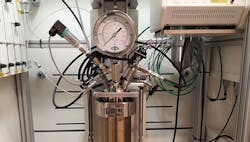Wood-Based Route Yields Phenol
Figure 1. Reductive catalytic fractionation of birch produces carbohydrate pulp suitable for bioethanol production.
A wood-to-chemicals process is economically competitive and has a lower carbon dioxide footprint than fossil-fuel based production, say its developers, a team of bio-engineers and economists from Katholieke Universiteit Leuven (KU Leuven), Leuven, Belgium.The process is based on an integrated biorefinery that converts 78 wt. % of birch wood into xylochemicals. Reductive catalytic fractionation of the birch gives a carbohydrate pulp amenable to bioethanol production plus a lignin oil. After extraction of the lignin oil, the crude, unseparated mixture of phenolic monomers undergoes catalytic gas-phase hydroprocessing/dealkylation to produce 20 wt. % phenol and 9 wt. % propylene.
The residual phenolic oligomers (30 wt. %) are being tested as printing ink replacements by Lawter, Chicago, Ill.
“The integrated biorefinery work was demonstrated in the lab scale as a proof of concept,” says Bert Lagrain, KU Leuven sustainable chemistry innovation manager. “Based on the results, we modelled an industrial scale able to produce 100 kton phenol starting from 1.4 million tons of birch wood, which is the size of a large pulp mill. Whether such a factory should be close to feedstock supply (wood) or to product off-takers (chemical companies) needs further investigation,” he adds.
The first phase of the scale-up will involve construction of a pilot reactor that can serve as a blueprint for an industrial process. “In our view, this installation should be able to deliver products on a kg scale. We are planning to build such a ‘lignin-first’ pilot ourselves that should be operational early 2021,” explains Lagrain, who notes that this step will cost €10–15 million ($11–16 million) when technology de-risking and intensive business development costs are included. Negotiations with investors are underway.
The main process challenges at this stage, he believes, are the catalytic fractionation step and separation at a large scale, including enabling them to run as continuous processes.
The process can be designed to manufacture other important chemical raw materials, such as furanics, polyols and light naphtha, from cellulose, Lagrain adds. It also can handle other hardwoods like eucalyptus and poplar; work is progressing on using soft woods such as pine and spruce, too.
Besides Lawter, the team is closely collaborating both with potential lignocellulose feedstock suppliers such as the pulp and waste industries and with chemical companies looking to replace their fossil-fuel-based feedstocks.

